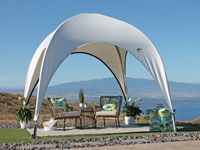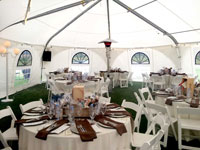Educators, parents, and students around the country are wondering when schools will reopen after closures due to COVID-19. While no simple answer to their questions exists, reopening dates will depend largely on schools’ ability to follow federal guidelines, including actions related to health and safety and ongoing monitoring. Social distancing measures figure prominently in these guidelines and may be particularly difficult to implement, so now is the time for school administrators to start preparing.
This guide is for informational purposes only. Refer to local, state, and federal government resources, including guidelines from the Centers for Disease Control and Prevention (CDC), when planning for the reopening of schools.
COVID’s Impact on the 2020 School Year
The majority of U.S. schools have closed since the COVID-19 outbreak hit the country in early 2020: At least 124,000 of the total estimated 138,000 private and public schools have cancelled in-person classes. These closures affect the schooling of at least 55.1 million U.S. students.
According to a CNN tally, officials in 48 U.S. states and Washington, D.C. have either ordered or recommended that these closures continue for the rest of the school year. As teachers struggle to provide remote learning and graduating classes accept the fact that they won’t get to experience a normal graduation ceremony, school officials are considering when and how to safely reopen schools.
When Should Schools Reopen?
The decision of when to reopen schools is complicated by somewhat conflicting guidance from the federal government. Federal guidelines issued in mid-April outline three phases to lift stay-at-home orders. Assuming that the amount of new COVID-19 cases has steadily declined for 14 days during phase one, states can begin to reopen schools in phase two.
However, these guidelines also caution against gatherings of more than 50 people during phase two, prompting much confusion at the inherent contradiction. Many U.S. schools have hundreds of employees and students, and reopening would necessarily mean exceeding the 50-person limit unless drastic changes were implemented.
Dr. Anthoni Fauci, director of the National Institute of Allergy and Infectious Diseases (NIAID) and one of the leading members of the White House Coronavirus Task Force, acknowledges the complexity of the decision and suggests that school officials make plans “on a step-by-step basis”: “We have a very large country, and the dynamics of the outbreak are different in different regions of the country, so I would imagine that situations regarding school will be very different in one region versus another.”
The CDC’s Guidelines for Reopening Schools
To clear up some of the confusion and uncertainty regarding how schools should decide when to reopen, the Centers for Disease Control and Prevention published a tool in the form of a one-page decision tree in mid-May.
This decision tree begins with three questions: “Will reopening be consistent with applicable state and local orders? Is the school ready to protect children and employees at higher risk for severe illness? Are you able to screen students and employees upon arrival for symptoms and history of exposure?”
If an administrator answers “no” to any of those questions, they should not reopen their school district at this time. If they are able to answer “yes” to all of them, they can move on to the next two questions in the decision tree: “Are recommended health and safety actions in place?” and “Is ongoing monitoring in place?”
While these next two steps outline general actions administrators should take (such as “encourage social distancing through increased spacing, small groups and limited mixing between groups, if feasible”), school district leaders are “underwhelmed” by the specificity of the guidelines according to executive director of the American Association of School Administrators (AASA) Daniel Domenech. At the end of the day, school district superintendents will be responsible for making decisions related to when to reopen schools and how to implement the CDC’s recommendations.
[Related: How to Set Up a Drive-Through Testing Station]
Potential Social Distancing Measures for Reopening Schools
All of the measures outlined in the CDC’s guidelines will be challenging for schools to adopt, but actions related to social distancing stand out as being particularly demanding. How can schools ensure small groups, increased spacing, and limited mixing among hundreds of students and employees?
NPR interviewed educators, education officials, and public health experts around the country to assess what schools might look like when they reopen, and many of their ideas address this question specifically.
Distance Learning
The need for continued remote learning — in some capacity — is indisputable. Distance learning will not only help reduce the number of people that are in each building at any given time, but will also give school administrators more time to prepare for a full reopening and allow for regular sanitation and cleaning of buildings.
However, distance learning has its own drawbacks, including issues related to proper nutrition, childcare, child abuse, computers and Wi-Fi, and the distractions of trying to learn at home. For these reasons, distance learning is recommended as a means of helping schools transition back to in-person classes and not as a sole solution.
Different Attendance Policies
Many parents may choose to keep their kids at home even after schools reopen, and school administrators should be both prepared for and accepting of this. For instance, Denmark became the first European country to reopen schools in mid-March and now has a Facebook group called “my kid is not going to be a guinea pig for COVID-19” with nearly 40,000 members.
Schools will also need to adopt a more lenient policy for sickness-related absences and encourage parents to keep their children at home if they exhibit any symptoms at all.
No Large Gatherings
Per the CDC’s recommendation to encourage “small groups and limited mixing between groups,” schools will have to postpone sports games, assemblies, parent-teacher conferences, and the like. Even small-group extracurricular activities will likely be off the table, as they would promote mixing of students from different classrooms.
Similarly, school-wide lunches in the cafeteria won’t be possible. The American Enterprise Institute’s “A Blueprint for Back to School” recommends that schools either “serve meals in the classroom or in smaller cohorts in the cafeteria or offer grab-and-go boxed meals.”
Whereas a single student may have been exposed to hundreds of others in a typical school day before, now the idea is to limit interactions to the classroom unit itself as much as possible.
Smaller Class Sizes
Preventing large gatherings also means reducing class sizes. The fewer bodies in each classroom, the better for both students’ and employees’ health.
At Copenhagen International School in Denmark, each classroom now has a maximum of about 10 students. Typical-sized classrooms in New York City should be able to accommodate no more than 12 students while maintaining social distancing, according to Michael Mulgrew, the head of the city’s United Federation of Teachers (UFT).
School districts may need to determine what number makes most sense based on the average size of their classrooms, but any reduction from typical class sizes will be beneficial, especially if measures are put in place to limit mixing between classrooms.
Staggered Schedules
Reducing class sizes is easier said than done — where should schools put the extra students?
One option is to stagger schedules, such as splitting students up using shifts (some students attend class in person in the morning and others in the afternoon) or alternating days (one group of students attends class on Monday, Wednesday, and Friday one week and Tuesday and Thursday the next week). When not physically in class, students could engage in distance learning, and schools would thoroughly sanitize their facilities between each group change.
Additional Classrooms
Another way for administrators to reduce class sizes is to increase the number of available classrooms.
Considering that educators and parents have long been calling for smaller class sizes, and that the benefits of smaller class sizes are widely known and accepted, adding classrooms now could be a great investment for the future. Administrators can implement social distancing measures short-term while also setting their schools up for better class sizes long-term.
While typical construction would be both cost-prohibitive and too time-consuming, modular classrooms are a great option for schools that need to quickly add classrooms before reopening in the fall.
[Related: The Best School Buildings for Modular Classrooms]
Modular Classrooms
If adding additional classrooms is part of your school’s plan to reopen with social distancing, modular classrooms from Alaska Structures® are prefabricated building solutions that reduce setup time and quickly provide a versatile option to meet both immediate and future needs.
This portable classroom system can be installed in a matter of days so that schools can be prepared to reopen as soon as possible (construction is included free of charge). A central utility room with space for a refrigerator, sink, food prep area, and washer/dryer ensures that the classroom is fully equipped to meet student’s needs, eliminating any need to enter the main school building and mix with students and staff there.
Once reduced class sizes are no longer necessary, the modular building can be repurposed for use as administrative offices, training rooms, teacher lounges, research labs, childcare facilities, and other applications. You can also easily relocate the modular building to another school in your district to meet changing needs, regardless of education level.
Additional benefits of our fabric structures include:
- Spacious and bright interiors
- The most energy-efficient design in the industry, reducing overall operating costs
- Proprietary insulation systems that maintain a comfortable learning environment in any climate
- Virtually no maintenance (or maintenance costs) required after installation
- An ADA-compliant ramp and two emergency exits
- Additional air conditioning available
- Optional portable power generation and distribution systems
To learn more about our many fabric building systems or our other school building solutions and discuss your school’s unique needs, reach out to our knowledgeable building specialists.
Telephone: +1-907-344-1565
Or use our online contact form and submit your request.

















































































Leave a Reply